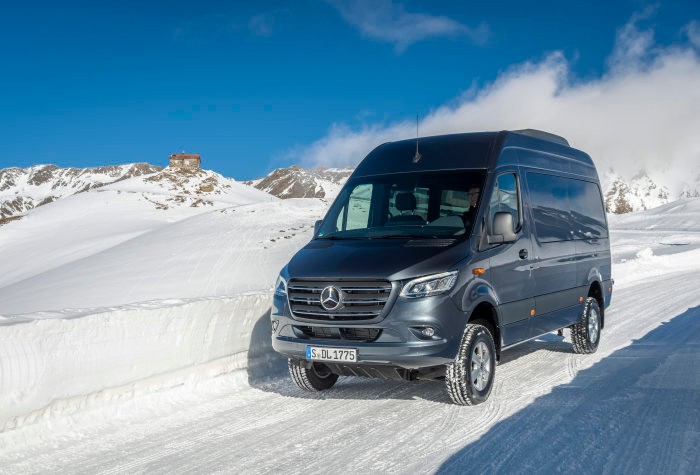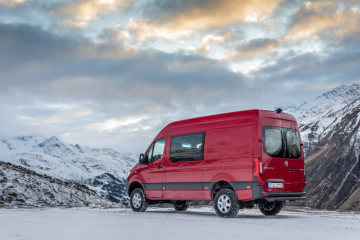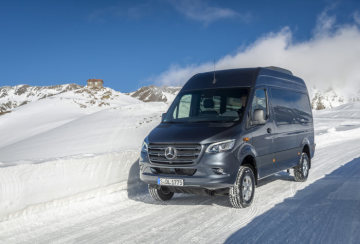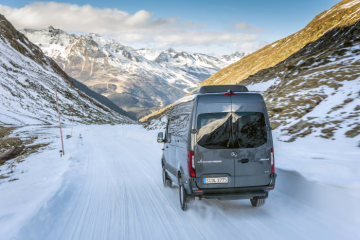
06.
December 2018
Stuttgart
- Fully integrated into the adaptive stability program ESP
- ASR can be disabled for defined driving situations
- Downhill Speed Regulation assists the driver in the mountains
- Assured traction with 4ETS and "Adaptive ESP"
Stuttgart. Outstanding handling characteristics and very good traction, plus the safety and superiority that are hallmarks of the brand: since its market launch in 2011, the Sprinter 4×4 has been recognised as being the epitome of a large van, capable of mastering even the toughest of driving conditions while still retaining all the comfort features of its counterparts with conventional drive configurations. The third-generation Sprinter with all-wheel drive feels just at home on various mountain passes as it does on temporary roads to construction sites. The entry-level price for the panel van with standard wheelbase is 46 272 euros (in Germany, excl. VAT), and 43 652 euros(excl. VAT) for a chassis version.
Fully integrated into the adaptive stability program ESP
The selectable all-wheel drive of the new-generation Sprinter improves traction. When the engine is running, it is selected either when stationary or at low speeds up to 10 km/h by operating a switch in the instrument panel. Under normal operating conditions, this driving mode sees the torque of the Sprinter 4×4 distributed to the front and rear axles in a ratio of 35:65 respectively. This ensures handling characteristics that differ only marginally from those of the rear-wheel drive Sprinter in day-to-day operation.
The electronic traction control system 4ETS makes a major contribution to the optimal driving and handling characteristics. It is fully integrated into the electronic stability program "Adaptive ESP" and its control characteristics have been specially adapted for all-wheel drive. At the same time all the functions of Adaptive ESP are retained: anti-lock braking system (ABS), acceleration skid control (ASR), electronic brake force distribution (EBV), Brake Assist (BAS) and the Start-off Assist system (AAS).
If one or more wheels lose traction on a slippery surface, e.g. on snow or ice, 4ETS automatically brakes the spinning wheels with brief impulses, thus increasing the drive torque to the wheels with good traction. 4ETS uses the ABS wheel sensors for this purpose. The automatic braking intervention by 4ETS can match the effect of up to three differential locks: the inter-axle differential lock, rear axle lock and front axle lock.
ASR can be disabled for defined driving situations
Depending on the driving situation, the acceleration skid control (ASR) of the Sprinter 4×4 can be disabled for a short period using the menu buttons on the steering wheel. In this case the control thresholds are briefly extended to improve traction by allowing increased slip, e.g. when driving with snow chains or on gravel. The ASR function is automatically reactivated within a speed range of 40 to 60 km/h. The same applies if slip increases excessively, or after more than ten seconds in "ASR Off" mode. ESP always remains active in all situations.
However, 4ETS avoids critical driving situations in the first place. As the speed increases, the locking effect within an axle is reduced to prevent yawing motions (rotation around the vertical axis) in the interests of driving stability. Despite this intervention, overheating of the braking system is not possible: if the temperature of the brakes rises to an undesirable level during extreme off-road operations, 4ETS reduces the locking effect automatically until the brakes have cooled again. The driver is made aware of this by means of an indicator lamp.
Recognition of the load and centre of gravity (Load Adaptive Control LAC) is particularly important in view of the many body variants and conversions available for the Sprinter. In the case of special-purpose bodies, for example, Adaptive ESP registers a high centre of gravity and adapts the control characteristics accordingly. When driving off-road, Adaptive ESP thereby improves safety, e.g. when driving along inclines with large tilt angles.
Downhill Speed Regulation (DSR) is optionally available in conjunction with the reduction gear. It ensures that a preset speed is maintained when descending a gradient. This is made possible by interaction between the engine, transmission and specific braking intervention. DSR is activated by a button in the cockpit. The speed is then regulated by a rocker on the steering wheel. Mercedes-Benz can also optionally equip the Sprinter 4×4 with a hill-holder – ideal when driving in wintry conditions.
Even more traction: the Sprinter 4×4 with reduction gear
The all-wheel drive van is also optionally available with the additional "Low Range" reduction gear. When switched on with the vehicle stationary and the engine running, with 4×4 mode activated and the clutch operated or in automatic transmission position "N", this lowers the transmission ratio by 42 percent. The maximum speeds in the individual gears are correspondingly reduced. Tractive power increases at the same time. This means that the Sprinter 4×4 can now be driven off-road with circumspection at low speeds, saving wear to the clutch. Use of the reduction gear is recommended during frequent slow manoeuvring to reduce clutch wear, on extreme gradients in mountainous regions and when driving with a full load or towing a trailer off-road.
Raised body level in the interests of off-road capabilities
While the Sprinter 4×4 does not claim to be an off-roader, raising the body by 155 millimetres at the front and 135 millimetres at the rear already gives a visual indication of typical off-road characteristics.
For example, the angle of approach of the Sprinter with 3.5 tons permissible gross vehicle weight is 26 degrees rather than 16 degrees for the Sprinter with conventional rear-wheel drive, and the angle of departure is 25 degrees (versus 17 degrees) for the panel van with short overhang. The breakover angle – which is important when negotiating hill crests – is 23 degrees rather than 14 degrees for the Sprinter 4×4 with standard wheelbase.
Depending on the engine variant, the gradient climbing ability is around 20 percent better than that of a conventionally powered Sprinter. At the same time its full day-to-day suitability in demanding commercial operations is fully retained: the weight increase compared to conventional drive configurations is a mere 140 kilograms. The load capacity remains the same.
Press Contact
- Product Communications Mercedes-Benz Citan, Vito, Sprinter
- albrecht.eckl@daimler.com
- Tel: +49 711 17-52131
- Fax: +49 711 17-52038
- Product Communications Mercedes-Benz Vans
- peter.feneberg@daimler.com
- Tel: +49 711 17-47117
- Fax: +49 711 17-79057555
Press Contact Overview
Media
Download
Filter
Show thumbnails
Show list
Slideshow

Do you really want to delete the data record?
Please wait a moment …
Please wait a moment …
Please wait a moment …
Please wait a moment …

LoadingOriginal Article





